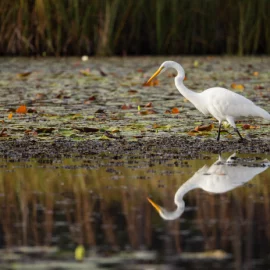
Our receding coastlines are now and always will always be here and trying to save them is and will be a never ending proposition.
Louisiana is about halfway through spending $50 billion in a multi-year plan to address the state’s fast-receding coastline. Since 2007, Louisiana has secured $23 billion for the projects that created 52,000 acres of new land, built 358 miles of new levees, and improved 60 miles of barrier islands, Chip Kline, the head of the CAPRA board told the Press Club of Baton Rouge on Monday. Next year, the Louisiana Coastal Protection and Restoration Authority will be asking legislators to approve another State Coastal Master Plan, which also to the tune of $50 billion. Still, that won’t be enough. “We are never going to get to a point in time where we are done,” said Kline, who in addition to running CPRA, is the director of Coastal Activities for the State of Louisiana and thus in charge of the coastal program. “You are always going to have a long-term plan that looks at the long-term sustainability of the state of Louisiana,” he added. “We’re now on the third iteration of the plan, which was passed in 2017, and next one will be submitted to Louisiana Legislature in 2023 that, right now, is looking like another $50 billion plan” for projects over tens of years.
theadvocate.com
This is not really news to those of us who have been following the efforts to fix the coasts.
The state is expected to spend $1.3 billion for the fiscal year that begins July 1 to fund 142 projects and 23 dredging projects that will add 16,000 acres of new land to coastal marshes that have been disintegrating for 80 years since the levees built to stem flooding has kept the Mississippi River overflows from spreading sediment through the marshes. That $1.3 billion is roughly the same amount that all the campuses in the LSU System, including the two medical schools, receive in funding for the fiscal year. The U.S. Corps of Engineers is spending an additional $2.6 billion of federal money in Louisiana. When federal and state money are added together, the $3.9 billion amount spent puts coastal projects in the same league as annual spending on public schools or for healthcare for 20% of the state’s population. The state’s money comes from the Gulf of Mexico Energy Security Act of 2006, called GOMESA, which is revenue-sharing for oil and gas production in states along the Gulf of Mexico plus tax revenues from production of energy within Louisiana and surplus dollars.
The Governor will announce the funding and I wonder what will happen when a republican is elected to the governor. Will they continue or will they not.
Gov. John Bel Edwards on Tuesday at 1 p.m. will join the Coastal Protection and Restoration Authority for Coastal Day to announce funding plans for coastal projects. Global warming is expected to increase sea levels over the next 50 years. But the immediate problem is that when the sediment of the Mississippi River was cut off by the levees built in the 1930s, marshes stopped building, which allowed salt-water intrusion and the land to subside. The projects are addressing those issues. “All we’re doing is hitting reset,” Kline said. If we don’t do that the estuaries are going to continue to collapse our ecosystem will continue to fail our coast going to continue to disappear, Kline said.
We have a choice, fund the restoration or write off a large chunk of the southern part of the state.



